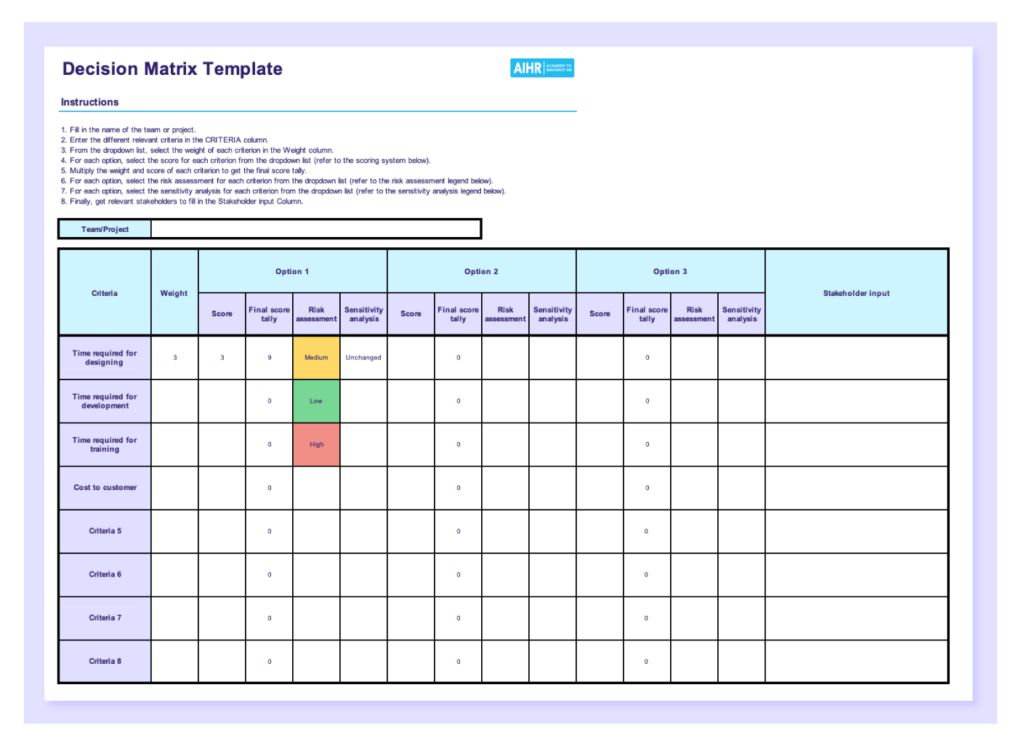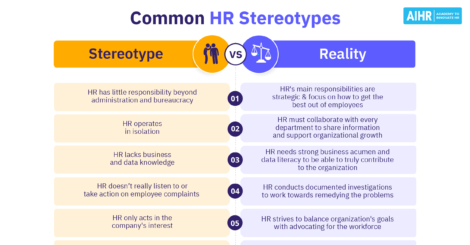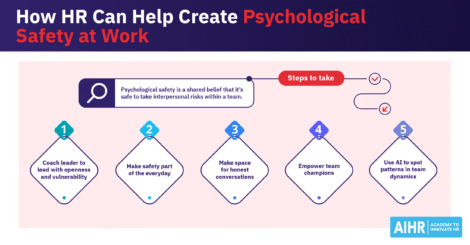A decision matrix template can help HR professionals make more informed choices about recruitment, employee engagement strategies, and even HRIS purchasing. This structured approach to decision-making improves objectivity and efficiency.
This is especially valuable given that 57% of HR professionals are currently working beyond their normal capacity, according to SHRM. Rather than struggling to juggle multiple priorities, HR teams can use decision matrix templates to streamline complex decision-making, freeing up time and resources to focus on strategic initiatives.
This article explains the key elements of a good decision matrix template, offers 9 steps to using a template and provides a free decision matrix template to help you get started.
Contents
What is a decision matrix?
The benefits of a decision matrix template
8 key elements of a good decision matrix template
Types of decision matrix templates
Free decision matrix template (Excel)
9 steps to use a decision matrix template
What is a decision matrix?
A decision matrix is a powerful analytical tool used to evaluate and compare multiple options based on predefined criteria. Also known as a decision-making matrix template, this structured approach helps individuals and organizations make more informed, objective choices by systematically weighing various factors.
A decision matrix can be valuable for HR professionals who need to consider multiple variables simultaneously for tasks like candidate selection, performance evaluation, and policy implementation.
The decision matrix is a tool for comparison, and for enhancing objectivity and efficiency in the decision-making process. Users can assign weights to different criteria and score each option accordingly, offering a quantitative analysis to make decisions. This helps reduce bias and improves overall decision-making efficiency by clearly presenting each option’s pros and cons.
The benefits of a decision matrix template
A decision matrix template follows a structured approach to evaluating multiple options against predefined criteria. This helps decision-makers compare and prioritize alternatives in a clear, organized manner. The template can also help bring clarity to complex choices and ensure all relevant factors are considered before reaching a conclusion.
Here are a few key benefits of using a decision matrix template:
- Users are less likely to overlook important factors in the decision-making process
- Decision-makers can evaluate options based on concrete criteria rather than intuition or personal preferences, minimizing bias
- The template can help make more accurate and faster decisions once you establish the relevant criteria and options
- It also facilitates data-driven decisions by allowing decision-makers to easily use tangible evidence to quantify the assessment of each option against the predefined criteria.
HR tip
A decision matrix helps to promote transparency and accountability. This framework makes it easy for others to understand the reasons and methods behind different decisions. You can also make the most of decision matrix templates’ data-centric approach to demonstrate a methodical, evidence-based decision-making process that’s also transparent and accountable.
8 key elements of a good decision matrix template
A well-designed decision matrix template includes several key elements to ensure a comprehensive, balanced, and insightful analysis. Here are the elements of a good decision matrix template:
- List of criteria: This list shows the factors against which you’ll evaluate each option. By carefully selecting and defining these criteria, you can consider all relevant aspects of the decision-making process. This will, in turn, support a comprehensive and balanced assessment.
- Weighting: While not always necessary, weighting can significantly improve a decision matrix’s accuracy. Assigning relative importance to each criterion gives a more nuanced evaluation that reflects real-world priorities. So, a weighting system helps prevent less critical factors from excessively influencing the final decision.
- Scoring system: Whether you use numerical scales, percentages, or qualitative ratings, you should define the scoring method upfront and apply it uniformly across all options. This standardization helps reduce bias and ensures fair and meaningful comparisons among alternatives.
- Options or alternatives: This is where you list the various choices under consideration. Clearly describe each option to avoid ambiguity and include all viable alternatives in the matrix so that you don’t overlook potential solutions. Doing this will help you make more informed decisions.
- Stakeholder input: As with any organization, avoid making any major decisions in isolation. Instead, include a section on your template to record input from relevant stakeholders, which can provide valuable perspectives and increase buy-in for the final decision.
- Sensitivity analysis: All criteria, no matter how objectively determined, are based on a set of educated assumptions. To test your theories, include a sensitivity analysis section where you can adjust weights or scores to see how each option might affect the final outcome. Predicting whether each option will worsen or improve the outcome (or leave it unchanged) will help you test the robustness of your decision.
- Final score tally: The final score tally provides a simple comparison between alternatives and is usually also the basis for the final decision. However, while it’s informative, it should not be the sole factor in complex decisions.
- Risk assessment: A column listing the level of risk associated with each option can provide a more comprehensive view of all the alternatives, particularly when weighted against the final scores. You can then use this information to decide if each option is worth exploring based on its importance and the risk it carries.
Make data-driven decisions with confidence
Making decisions in a structured, data-driven way just like with a decision matrix template is an important skill to develop as an HR professional.
In AIHR’s HR Metrics & Dashboarding Certificate Program, you can learn how to use Excel to analyze data, gain actionable insights, and make data-informed decisions.
This online, self-paced Certificate Program will also teach you how to understand and implement metrics to become the driving force for data-driven HR.
Types of decision matrix templates
There are a few popular types of decision matrix templates, each offering distinct benefits. You can apply them to a wide range of HR decision-making situations, from recruitment and employee development to policy formulation and strategic planning. Below is an overview of these decision matrix template types:
1. Weighted decision matrix template
A weighted decision matrix template compares multiple options based on various criteria and assigns each criterion a specific level of importance (or weight). Also known as a ‘prioritization matrix,’ this weight reflects the extent of each criterion’s impact on the overall decision or its priority to the business.
This template is suitable for when certain factors are more critical than others. It can help you make decisions that are not only data-driven but also aligned with organizational priorities, reducing bias and ensuring you consider important factors adequately.
Practical HR applications
- Hiring decisions: You can use this template to evaluate candidates according to different weighted criteria. For instance, programming would carry more weight for a technical role, while interpersonal skills would carry more weight for a customer-facing position.
- Policy development: You can evaluate different policy options by reviewing legal compliance, alignment with company values, impact on employee morale, and potential costs. For instance, you’d weigh work-life balance more heavily than administrative ease when developing a new leave policy.
2. Non-weighted decision matrix template
A non-weighted or unweighted decision matrix template is a simpler version of a weighted decision matrix template, It evaluates options without assigning weights to criteria, as it considers all criteria equally important. It typically includes a list of options, a set of criteria, and a scoring system.
This template scores each option against each criterion, basing the final decision on the total scores. Although it doesn’t account for varying degrees of importance among the criteria, the template is still a structured way to compare alternatives. It’s useful in cases where all factors have similar significance or when you need a quick, straightforward comparison.
Practical HR applications
- Initial candidate screening: A non-weighted matrix can help you quickly compare candidates according to basic qualifications, which is especially useful when you have multiple applicants to assess.
- Office supply vendor selection: For routine decisions like this, a non-weighted matrix can use criteria like price, delivery time, product range, and customer service quality to help you reach a sound decision quickly.
- Training format selection: When deciding between different training delivery methods (e.g., in-person, online self-paced, or live virtual sessions), you could use an unweighted matrix with criteria like cost-effectiveness, time flexibility, interactivity, and potential reach.
3. Eisenhower decision matrix template
Also known as the Urgent-Important Matrix, this template is an excellent tool for prioritizing tasks and making decisions based on their urgency and importance. It divides tasks into four quadrants: Urgent and Important, Important but Not Urgent, Urgent but Not Important, and Neither Urgent nor Important.
This categorization enables individuals and teams to allocate their resources more efficiently, improve time management, and increase overall productivity. This template is suitable for a fast-paced environment where competing priorities are common.
Ultimately, it can help you distinguish between tasks that require immediate attention and those that contribute to long-term goals, ensuring a balance between reactive and proactive work.
Practical HR applications
- Task prioritization: Prioritizing to-do lists allows you to handle critical tasks promptly and allocate time for important long-term projects.
- Time management: Categorizing tasks helps you manage your time better. It lets you focus on high-priority items in the ‘Urgent and Important’ quadrant while scheduling time for ‘Important but Not Urgent’ tasks that often contribute to strategic goals.
- Delegation: The matrix helps identify tasks in the ‘Urgent but Not Important’ quadrant you can delegate to team members, promoting people development and freeing up time for more critical activities.
4. Pugh decision matrix template
Also known as a multi-criteria decision analysis, this is a quantitative technique for concept selection and decision-making. It compares several design candidates against a reference concept or baseline, evaluating them based on multiple criteria. The Pugh matrix helps decision-makers objectively assess options, especially when considering multiple factors.
You can use this template when you need to compare several alternatives against a set of criteria simultaneously. The Pugh matrix is especially valuable when you have to justify decisions or build consensus among stakeholders with differing perspectives.
Practical HR applications
- Recruitment strategy selection: Use this template to compare different recruiting strategies (e.g., internal promotion, external hiring, using recruitment agencies) against criteria such as cost-effectiveness, time to hire, quality of candidates, and long-term retention rates.
- Employee benefits package design: You can also compare various benefits options against factors like cost to the company, perceived value to employees, market competitiveness, and administrative complexity.
- Human Resource Information System (HRIS) selection: Weigh different HRIS options against criteria such as functionality, user-friendliness, integration capabilities, vendor support, and total ownership cost.
Free decision matrix template (Excel)
We’ve developed a weighted decision matrix template in Excel to help you make better decisions in your HR role. Click on the button below to download the template:

9 steps to use the decision matrix template
Whether you’re using a simple decision matrix template or a more complex one, the fundamental steps for usage remain the same. Here are nine steps to follow to use a decision matrix template effectively:
Step 1: Define the problem or decision
Start by clearly articulating the issue you’re addressing or the decision you need to make. This step ensures you can keep your subsequent analysis focused and relevant. In an HR context, this could range from selecting a new HRIS system to choosing between multiple job candidates.
Step 2: Identify available options
List all viable alternatives or solutions to your problem. This might include selecting different vendors, determining policy options, or deciding between candidates. Brainstorming with your team can also help ensure you don’t overlook any important factors or potential solutions.
Step 3: Determine decision-making criteria
Establish the factors that will influence your decision. These should be measurable aspects that align with your organizational goals. For instance, when developing an employee training program, your list of criteria should include cost, relevance to skills gaps, and scalability.
Step 4: Assign weights to criteria (for weighted matrices)
If some factors are more crucial than others, assign a relative weight to each criterion. This step helps prioritize what truly matters in your decision-making process, ensuring alignment with HR strategic objectives.
Assigning weights to criteria: Tips from AIHR’s Subject Matter Expert
According to Annelise Pretorius, Psychometrics Assessments Expert at AIHR, the pairwise comparison method can be useful if you’re having trouble assigning relative weights to criteria. Here’s how to use this method:
- Directly compare each criterion against another in pairs, then assign a score based on their importance
- Add up the final scores for each criterion once you’ve compared all the pairs to get a clearer sense of their importance relative to one another
- Use this data to help ensure your decision matrix reflects the true priorities and trade-offs relevant to your final decision.
Step 5: Score each option
Evaluate how well each alternative meets the established criteria. Use a consistent rating scale (e.g., 1 to 5 or 1 to 10) to maintain objectivity. This systematic approach will help you compare your options on a level playing field.
Step 6: Multiply scores by weights (if applicable)
For weighted decision matrices, multiply each score by the weight assigned to its corresponding criterion. This step ensures a proportional impact of the different factors on the final decision (i.e., more important factors have a greater impact than less important factors).
Step 7: Sum the scores
Calculate the total score for each option by adding up all individual scores (or weighted scores). This provides a quantitative basis for comparison, helping you and your team make better data-driven decisions.
Step 8: Review results and make a decision
Analyze the final scores, but remember the highest score isn’t always the automatic winner. Use the results as a guide, considering any qualitative factors not captured in the matrix. This step allows you to balance analytical insights with your and your team members’ expertise and intuition.
Step 9: Implement and monitor
Once you’ve made your decision, create an implementation plan. Regularly monitor the outcomes to ensure the chosen solution is effective. This ongoing evaluation is crucial for HR policies, allowing for timely adjustments if needed.
To sum up
Decision matrices are valuable tools for HR professionals to make more objective, efficient, and data-driven decisions. They help structure the decision-making process by evaluating multiple options against predefined criteria, reducing bias, and improving consistency.
Decision matrices can quantify and visualize complex choices, empowering you to justify your decisions with concrete data and enhancing transparency and accountability in areas like recruitment, policymaking, and resource allocation.
The structured approach of decision matrices improves the quality of HR decisions and saves time and resources by streamlining the decision-making process. This allows you to focus on strategic initiatives rather than getting bogged down in deliberation.


















